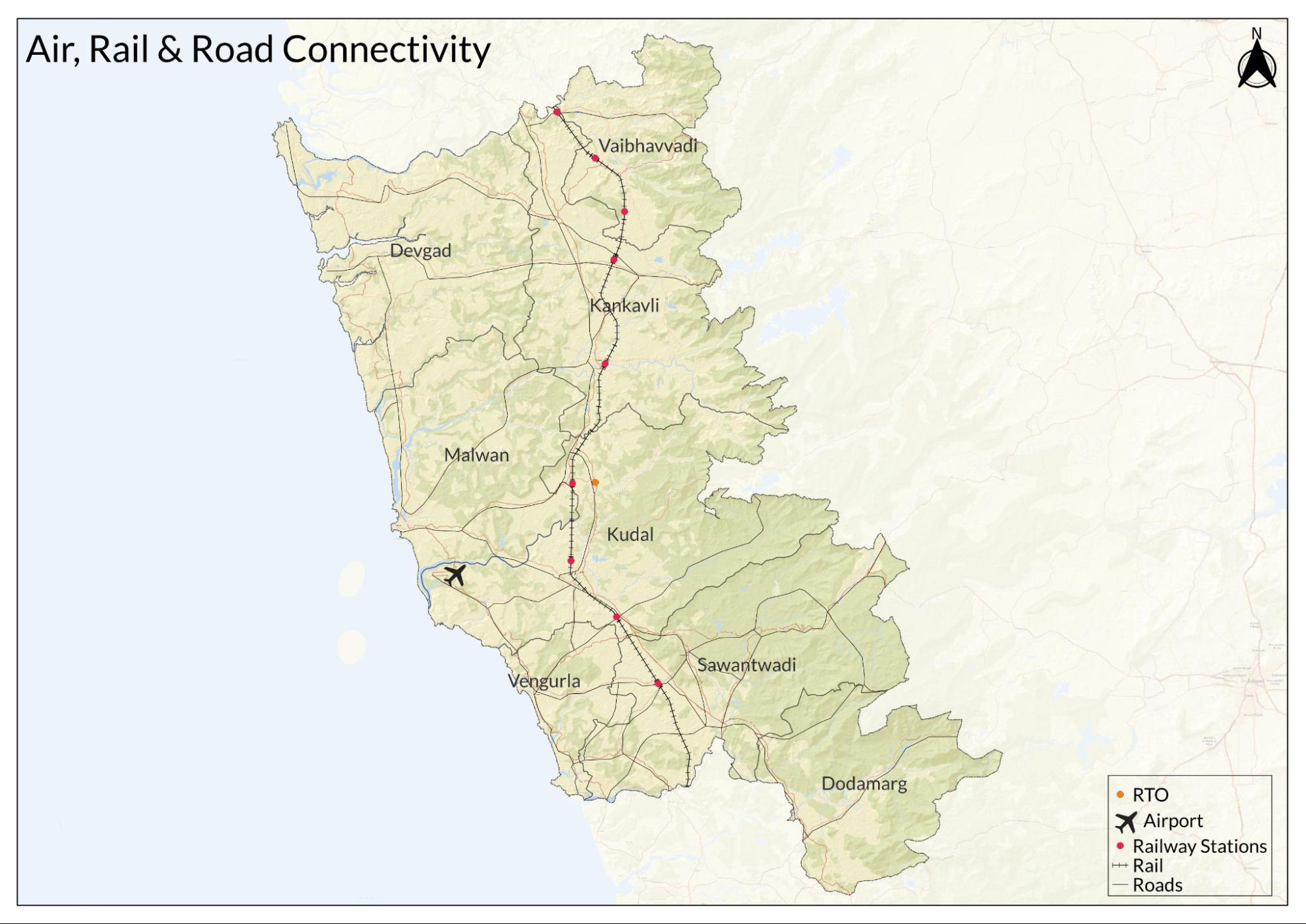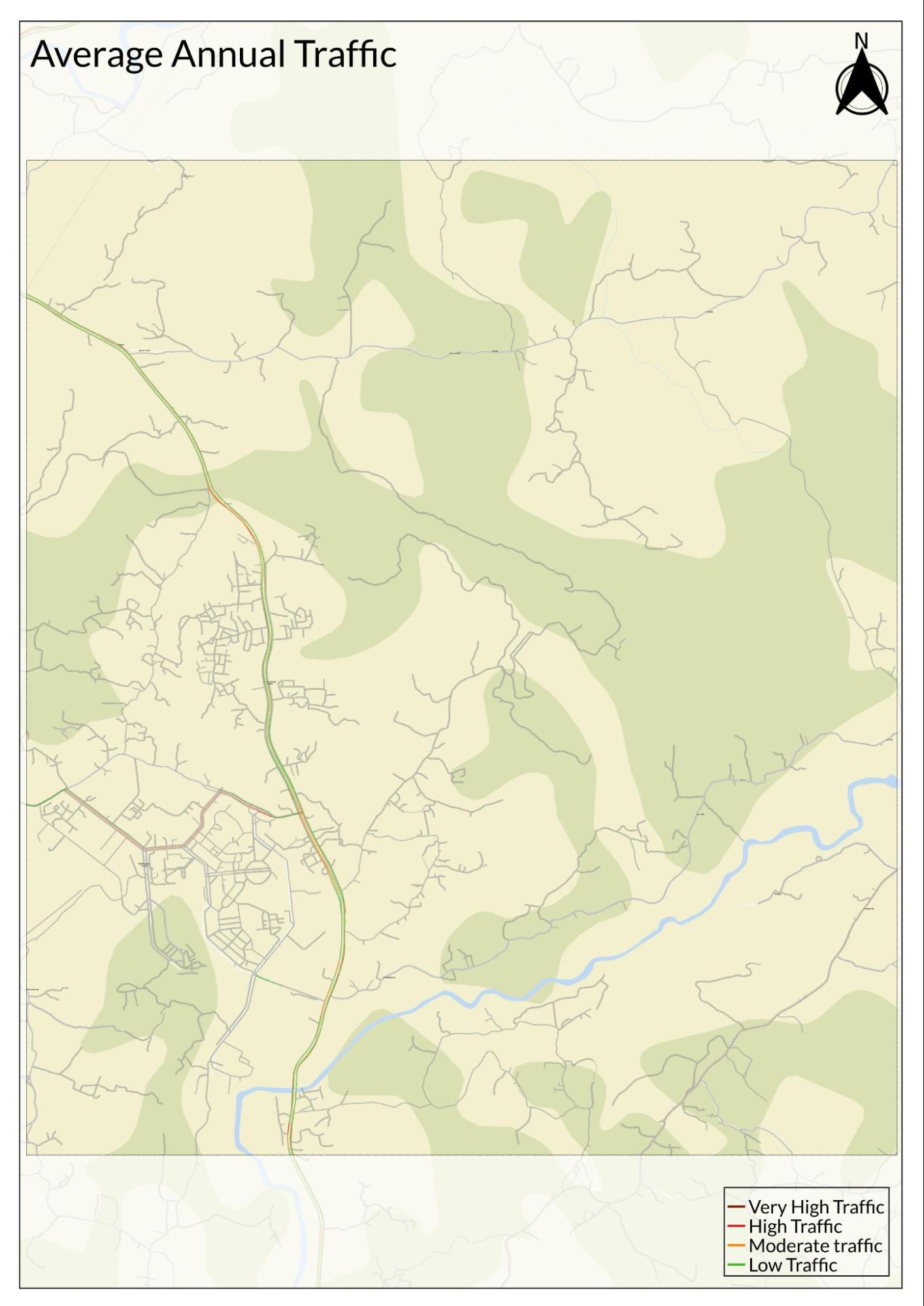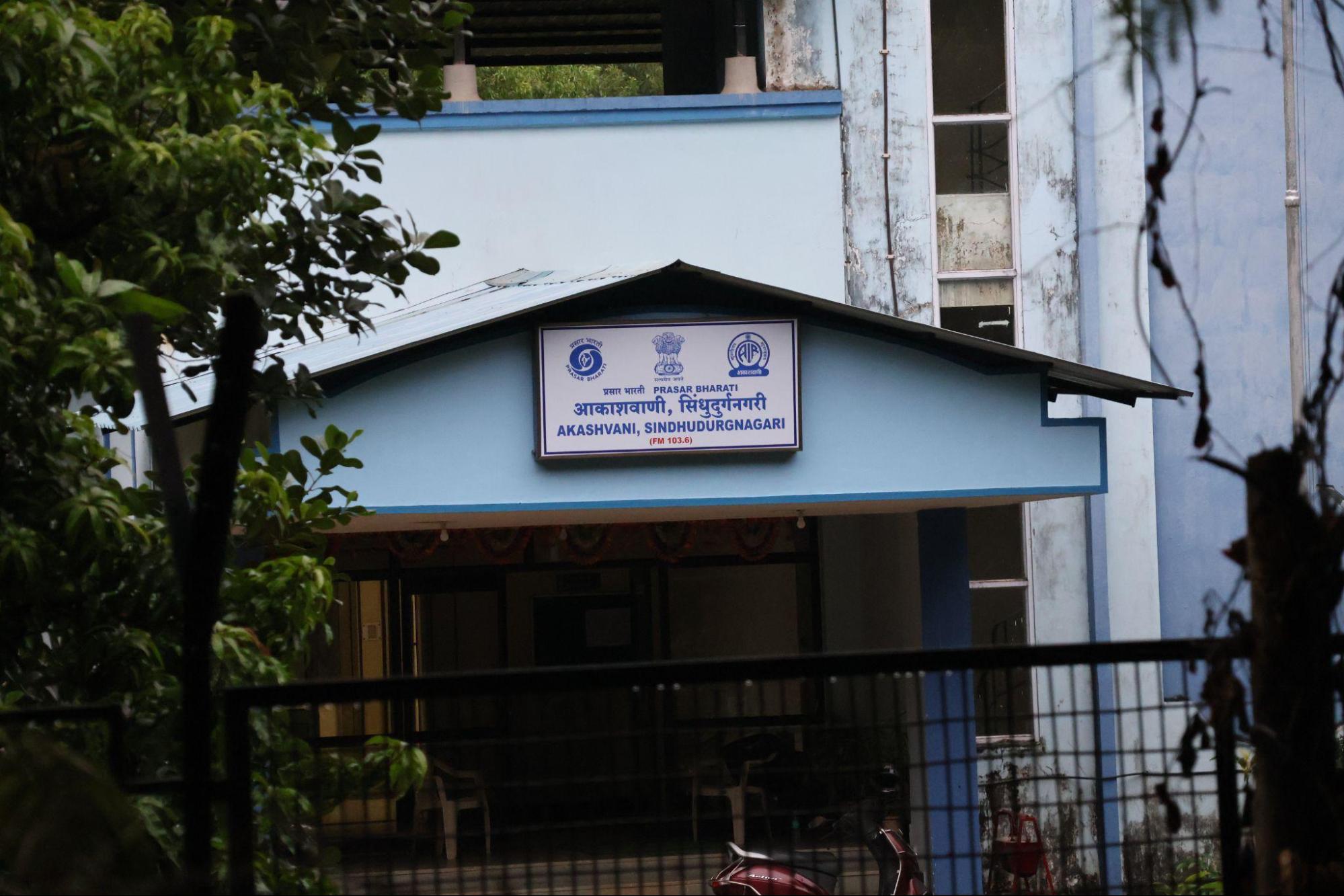Contents
- History
- Ancient Trade Routes
- Ports and Coastal Trade Hubs
- Vijaydurg and Jayatpura
- Road Connections and Inland Routes
- Modes of Transport
- Train and Rail Systems
- Overview of Bus Networks
- Ferries and Water Transport
- Autos & Shared Vehicles
- Air Travel
- Traffic Map
- Communication Networks
- Newspapers & Magazines
- Radio & Broadcasting
- Graphs
- Road Safety and Violations
- A. Cases of Road Safety Violations
- B. Fines Collected from Road Safety Violations
- C. Vehicles involved in Road Accidents
- D. Age Groups of People Involved in Road Accidents
- E. Reported Road Accidents
- F. Type of Road Accidents
- G. Reported Injuries and Fatalities due to Road Accidents
- H. Injuries and Deaths by Type of Road
- I. Reported Road Accidents by Month
- J. Injuries and Deaths from Road Accidents (Time of Day)
- Transport Infrastructure
- A. Household Access to Transportation Assets
- B. Length of Roads
- C. Material of Roads
- Bus Transport
- A. Number of Buses
- B. Number of Bus Routes
- C. Length of Bus Routes
- D. Average Length of Bus Routes
- E. Daily Average Number of Passengers on Buses
- F. Revenue from Transportation
- G. Average Earnings per Passenger
- Communication and Media
- A. Household Access to Communication Assets
- B. Newspaper and Magazines Published
- C. Composition of Publication Frequencies
- Sources
SINDHUDURG
Transport & Communication
Last updated on 6 November 2025. Help us improve the information on this page by clicking on suggest edits or writing to us.
History
Ancient Trade Routes
Trade routes and coastal transit systems have long shaped the history of Sindhudurg district, reflecting its strategic position along the Konkan coast. The coastal towns and ports here once formed part of an extensive maritime network connecting India’s western seaboard to distant markets across the Arabian Sea and beyond.
According to the colonial district Gazetteer (1880), before the Portuguese consolidated their control in 1510, Sawantwadi was an important node in these coastal trade routes, with Banda known as a thriving market centre. This prosperity, however, faced disruption with the Portuguese presence, which brought new maritime rivalries and shifts in trade patterns. Local commerce declined through the 16th century, and by the 18th century, it is said that political changes further eroded the region’s once-flourishing trade links.
One place that offers insight into these early shifts is Vengurla, a port town just north of Goa. Vengurla’s coastal position made it a strategic site in the rivalry between European powers. The Dutch East India Company, seeking to weaken Portuguese control, established a trading outpost here in 1665. Vengurla became a safe natural harbour where commodities such as cloth, millets, cardamom, and salt were shipped out, and goods from the Deccan flowed down for export. Notably, on this period in Vengurla’s history, Gogwekar (2022) writes, “The Dutch set down roots in Vengurla and continued to trade from here. During this time, the town reached its zenith as the Dutch traded with countries like Persia, Batavia (modern Jakarta), Malacca, and Japan, and many others.”
The Dutch legacy remains visible today in the form of surviving structures like the Dutch Wakhar (warehouse) and colonial-era landmarks such as St Luke’s Hospital and Crawford Market, which stand as reminders of Vengurla’s role in the broader Indian Ocean trading world.

The region’s maritime history is also intertwined with the Sawant rulers. By the early 18th century, Khem Sawant II took advantage of Maratha–Mughal conflicts to wrest Vengurla back under local control, strengthening Sawantwadi’s naval and commercial base. The town of Amboli, now a quiet hill station, was once a vital staging post on the inland road linking the port of Vengurla with Belgaum (Karnataka). This route was important for both trade and military supply, especially during the British period, when it helped maintain garrisons deeper in the Deccan.
Ports and Coastal Trade Hubs
Several small ports along Sindhudurg’s coast handled local exports and imports well into the colonial period. Each developed specialisations shaped by local crops, fishing, and access to inland routes:
- Devgad Port was known for sending hemp, betel leaves, sugarcane, and bamboo to Bombay. Rice, groundnuts, tiles, tobacco, and salt came back in return.
- Achra Port, today a village, once traded in coir, hemp, sugarcane, and earthen pots, sending these to Bombay and receiving rice and hardware.
- Malvan Port exported rice, hemp, linseed, cashew, kokum rinds, coir, and chillies. Its ships carried these goods to Bombay and south to ports like Honavar, Cochin, and Calicut, while imports included wheat, gram, oil, and British piece goods.
Vijaydurg and Jayatpura
Farther north, the Vijaydurg division stood out for its deep natural harbour and larger volumes of trade. The Gazetteer records that by the late 19th century, Vijaydurg handled over £200,000 worth of exports and imports each year, including gallnuts, molasses, hemp, and rice bound for Bombay, Goa, and the Malabar Coast.
Jayatpura, a principal port under Vijaydurg, shipped rice, spices, oils, and tobacco to places as far as Muscat (Oman) and Kozhikode (Kerala), and imported salt, hardware, and textiles.
Road Connections and Inland Routes
To sustain this maritime trade, inland road connections were equally vital. The British, recognising this, improved traditional passes and built new cart roads. The Ram Pass Road, completed in 1821, was one such crucial link. Stretching about 77 km, it connected the port of Vengurla to Belgaum (in present-day Karnataka), winding through dense forests and steep valleys. Over the decades, this route became a lifeline for traders and pack-bullock caravans carrying rice, hemp, salt, and coconuts inland.
Further north, the Amboli Pass was another vital link. By the 1860s, the British had upgraded it with sturdier roads and iron bridges.

Animal-drawn carts remained the backbone of inland haulage until well into the 19th century. Bullock caravans, called Vanjaris, traversed these rugged routes seasonally, carrying rice, hemp, salt, and coconuts from the coast to the markets of Kolhapur and deeper into the Deccan.
Modes of Transport
Train and Rail Systems
Sindhudurg district’s railway network is part of the Konkan Railway, which falls under the Karwar Division of the Konkan Railway Corporation Limited (KRCL). This line, extending about 761 km from Mumbai to Mangalore, remains one of India’s key coastal rail corridors. Opened for full traffic on 26 January 1998, the Konkan Railway has played a significant role in improving connectivity along the western coast. Most stations in Sindhudurg fall under B- and C-grade categories, with around 50 to 100 trains passing through daily. However, according to local accounts, these stations are rarely used for routine travel within the district, partly due to their placement along the line and the region’s reliance on road networks for shorter distances.
Sawantwadi Road station, in particular, has long been considered somewhat isolated from the main town. To make better use of this station and attract travellers, the Konkan Railway Corporation collaborated with the Maharashtra Tourism Development Corporation (MTDC) to develop a hotel on railway-owned land near the station. This initiative was intended to increase passenger traffic and support local tourism, addressing the limited use of the station due to its location.

Overview of Bus Networks
The Maharashtra State Road Transport Corporation (MSRTC) plays an important role in maintaining public transport across Sindhudurg. The district’s bus network centres on seven main depots, known locally as Agaars: Sawantwadi, Malvan, Kankavali, Devgad, Vijaydurg, Kudal, and Vengurla. These bus services connect towns and villages within Sindhudurg and link the district to larger urban centres in the Konkan region and beyond.
Ferries and Water Transport
Sindhudurg is shaped by seven major rivers, namely the Terekhol, Gad, Karli, Achara, Devgad, Kalaval Creek, and Waghotan, which have long influenced how people travel and trade here. Where bridges are few or the monsoon makes roads impassable, ferries and small boats remain essential for crossing these waterways and connecting scattered settlements.
In villages like Arunda, Kalna, and Chendvan, small wooden boats have supported daily life for generations. It is noted in the colonial district Gazetteer (1880) that Koli fishing families and farmers rely on many such vessels to carry people and local goods such as rice, coconuts, and firewood. Hodis, carved from mango trees, and donis, built from planks by local carpenters, served mainly for rowing. Larger machhvas with lateen sails helped navigate longer coastal stretches. While most parts were crafted locally, strong ropes were brought in from Mumbai.
Coastal ports such as Vengurla and Redi were once busy nodes along these river-linked trade routes. They connected Sindhudurg’s produce to wider Konkan and Arabian Sea shipping lanes, leaving behind a maritime legacy that still shapes local travel and livelihoods today.
Autos & Shared Vehicles
In many parts of Sindhudurg, auto-rickshaws continue to provide short-distance travel where bus routes do not reach. Unlike urban centres where meters are mandatory, most auto-rickshaws in this region operate without meters. Fares are typically negotiated beforehand and depend on the agreed distance.
Air Travel
Sindhudurg district is served by Sindhudurg Airport, also known as Chipi Airport, located near Parule-Chipi in Vengurla taluka. The airport became operational in October 2021 under the central government’s UDAN (Ude Desh ka Aam Nagrik) regional connectivity scheme. It is managed by IRB Sindhudurg Airport Pvt. Ltd., a subsidiary of IRB Infrastructure Developers.

The establishment of Sindhudurg Chipi Airport traces back to the early 2000s when the need for improved air connectivity in the district became apparent. Known for its picturesque beaches and tourist attractions, Sindhudurg lacked an airport, which limited its potential for tourism and economic development. The Maharashtra Industrial Development Corporation (MIDC) initiated the airport project, selecting Parule, near Malvan, as its location. The Government of Maharashtra and the Airports Authority of India (AAI) approved the project.
Construction of the airport commenced in 2011 on a Greenfield site, meaning it was built from the ground up rather than developing an existing facility. This project involved land acquisition, runway construction, terminal building, and installation of navigational aids and other infrastructure.
After several delays, Sindhudurg Chipi Airport officially opened for civilian operations on 9 October 2021. The airport is now seen as a key link for the Konkan region, expected to boost tourism and improve access for travellers visiting Sindhudurg’s beaches, forts, and coastal towns.
Traffic Map

Communication Networks
Newspapers & Magazines
The colonial district Gazetteer (1880) noted that while no newspaper was published in the region at the time, a lithographic press existed for official use. Since then, the district has developed its own local press. Prahar and Sindhudurg Samachar are among the newspapers currently published from within the district. These appear alongside widely circulated Marathi dailies such as Tarun Bharat, Lokmat, Pudhari, and Sakal.
While print newspapers remain in use, locals say that a shift toward digital consumption is evident. Mobile news apps, websites, and social media platforms have become common sources of information, especially among younger readers.
Radio & Broadcasting
Radios once played a central role in daily life across Sindhudurg. Around 25 years ago, locals say it was common for an entire village to gather around the one or two radios available to listen to news bulletins and entertainment programs, creating a shared space for information and community updates. Notably, Akashvani Sindhudurg, the district’s local broadcasting center, has long provided regional programming and continues to do so today.

In recent decades, however, radios have gradually given way to television and mobile phones, which offer more varied and on-demand content. As a result, fewer households rely on radio today, marking a shift in how residents access news and entertainment in the digital era.
Graphs
Road Safety and Violations
Transport Infrastructure
Bus Transport
Communication and Media
Sources
Aroosa Ahmed. 2018. Hotel at Picturesque Sawantwadi Railway Station. Hindustan Times.https://www.hindustantimes.com/mumbai-news/c…
Gazetteer of the Bombay Presidency: Ratnagiri and Savantvadi. 1880. Printed at the Government Central Press, Bombay.
Konkan Railway. 2015. Konkan Railway to Establish Tunnel Technology Institute at Goa as a Part of Its Silver Jubilee Celebration! Konkan Railway Corp Ltd.https://konkanrailway.com/en/node/3364
N.T. Monc, P.M. Joshi, P. Setu Madhava Rao, S.G. Panandikar, S.L. Karandikar, S.M. Katrc, and V.V. Mirashi. 1962. Maharashtra State Gazetteers: Ratnagiri District.Government Printing, Stationery and Publications, Mumbai.
Pranav Gogwekar. 2022. Vengurla: Konkan Port with a Dutch Connection. Peepul Tree.https://www.peepultree.world/livehistoryindi…
Sawantwadi Road Railway Station. Railyatri.https://www.railyatri.in/stations/sawantwadi…
World Health Organization.Road Safety. WHO, Geneva.https://www.who.int/health-topics/road-safet…
Last updated on 6 November 2025. Help us improve the information on this page by clicking on suggest edits or writing to us.